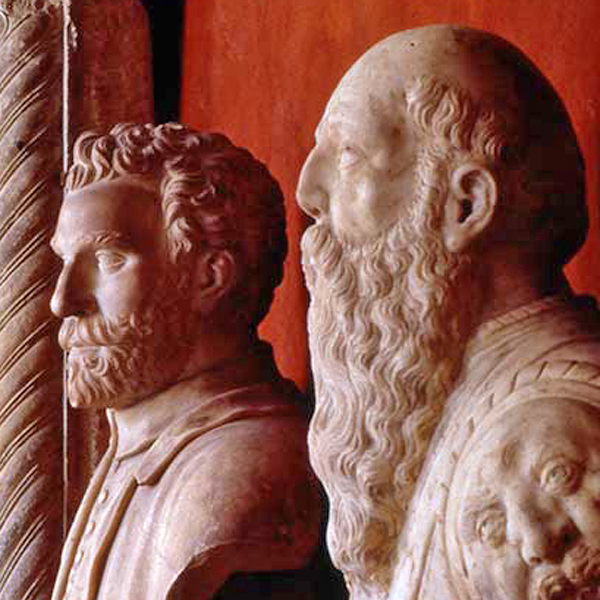“Portico dei marmi” and cloister
Portico dei marmi e chiostro
The southern wing of the cloister hosts the second section of don Gaetano Chierici’s Museum of Homeland History. Created in 1869 to combine Roman items in stone from the subsoil at Brescello with Roman and medieval items from Reggio Emilia, which had previously been collected under the portico of City Hall (1775), the wing was officially opened to the public in 1875, and the adjoining cloister was rearranged into a garden. A major expansion of the display area and important additions of medieval and renaissance materials were the work of Naborre Campanini, thanks to whom the collection took over the entire portico wing extending toward the Church of San Francesco. The result was worthy of a second inauguration, which took place on June 18, 1902, and was given the new name of Gliptoteca. In 1914, Campanini recognized that because of the influx of new materials, the items which were less subject to deterioration by inclement weather were best placed in the Cloister. The most bountiful additions were made between 1925 and 1932, with the acquisition of items in marble found in the area of the eastern necropolis of the Roman city of Reggio, and between 1933 and 1936, after a Roman sepulcher was discovered in Goleto di Boretto.
These addenda were accommodated in the outer area of the Cloister, which was subsequently reorganized to form an archeological garden thanks to the efforts of Giancarlo Ambrosetti. He is credited with further increasing the museum’s holdings, reworking the display path and reviving the name of Portico dei Marmi, as preferred by Chierici (1982-1991). The collection is distributed over ten sections. At the sides of a bust of Gaetano Chierici we find the altar-like headstones of the Julia family of Brescello. Toys made of lead in showcase 50 in the Chierici Museum refer to the stele of young Julia Graphis. Sections I-XIX in the northern gallery play host to funerary inscriptions and monuments. Firstly, the necropolises around Brixellum are documented; the capital associated with a pointed funerary monument (XXXIV) was found in this area. The most abundant documentation pertains to the burial ground at Regium Lepidi, and in particular to the eastern necropolis along the Aemilia road leading to Mutina, as follows: funerary monuments from recent digs in San Maurizio (1998-2000), with the inscription of a circumlator (transport agent) and steles with busts of two spouses (CLXXVI-CLXXIX); an inscription of elderly spouses C. Naevius Dromo and Naevia Philumina (LXVIII); cineraria (LVII, LXXV, LXXXI, XCI, C); gable-type steles by Q. Vennonius Felix, seviro (judge) (LXXI); altar-type stele of C. Fundanius Eucharistus, an officer of the imperial religion (claudialis), LXXVIII; stele of the family of C. Metellius Constans, a Roman veterano (LXXXVI); octagonal gravestone (LXXXVII); chart by P. Attiedius with a reference to the Pollia tribe, of which the regienses (inhabitants of Reggio) were members (LXXXVI); inscription in elegiac verses commemorating young Tinuleia Musa (LX); pseudoaedicule stele of Pettia Ge with wedding scene and marble-cutter’s tools depicted on the base (CXXX); sarcophagus of C. Decimius (CXXXI); stele of freedman C. Pomponius Felix, officer of the imperial religion (claudialis) and member of the professional board of wool carders (CXXXVIII). The series of Roman items in marble continues in sections XXXVIII-XLII, as follows: grave goods from the Gatta burial ground; stele, shaped like an Egyptian sarcophagus, of Publeia Tertia, priestess of Iside, from Campegine; grave goods from the city of Reggio and from the Goleto necropolis at Boretto, with stele for sepulchral application (CLXXV-CLXXVI); inscriptions commemorating the nine members of the family of the Papinii, from Poviglio (CLXI); stele of spouses T. Vibius Iustus and Camplana Aphrodite, from Goleto (CLXIV); base dedicated by Vibia Eutichia to her son Titus and her husband Ianuarius, from Goleto (CLXIV).
address
via Spallanzani, 1
42121 Reggio Emilia
T. +39 0522 456816
offices
via Palazzolo, 2
42121 Reggio Emilia
T. +39 0522 456477
F. ’39 0522 456476

